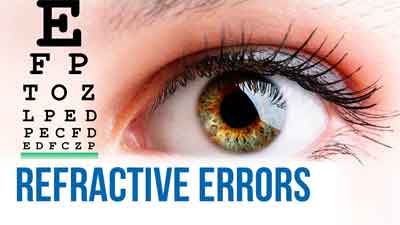Refractive error types, causes, symptoms?

Refractive error can affect one or both of your eyes. When an error is present in both eyes, it might not be equally serious for either one. Each of your eyes may also have a different refractive error. Errors in reflection are common. Globally, there are over 2.3 billion persons with at least one refractive defect that affects their vision.
Refractive errors are common vision problems linked to your eyes’ ability to focus. If you have this kind of eye issue, it will be difficult for you to see clearly because your eyes can’t focus as well. The image is focused around the back of the eye when people who have good eyesight look at something (retina). The object seems blurry and the vision isn’t perfectly centered around the retina if you have a refractive problem. Usually, changes to your vision occur gradually, and you may not notice them until you get an eye exam.
Side effects of refractive errors in eyes
REFRACTIVE ERRORS HAVE DIFFERENT SIDE EFFECTS. You may have at least one adverse effect, such as:
- Blurry vision- which occurs when you look at anything far away or when you turn everything off.
- tiredness
- headaches
- poor concentration.
RISK FACTORS
Refractive errors are more likely to affect some persons than others, including:
- Senior citizens. Up until the age of 70, your risk of developing hyperopia increases yearly. Your chance of developing nearsightedness increases after age 70. Because of the way your lens becomes more solid over time, older people are also likely to develop presbyopia.
- People who have refractive errors in their direct family. These problems typically run in families and may have a genetic basis.
A link between natural factors and the improvement of late-onset nearsightedness has also been found in a few studies. These consist of:
- Lack of outside Lack of outside time.
- use of LED lighting.
- protracted “near work,” or work done up close to your face.
- Poor sleeping patterns.
THE VARIOUS KINDS OF REFRACTIVE ERROR INCLUDE:
- Astigmatism- where your vision is blurry at all distances.
- Long-sightedness (hyperopia)- You have trouble focusing on close things because they appear blurry.
- Presbyopia- which is more common in those who are 40 years of age or older and causes difficulties reading or seeing objects up close.
- short-sightedness (myopia) — you have trouble focusing on distant objects, and they appear blurry.
GENETIC
There is an indication that the refractive defect may run in the family. People who have parents that suffer from a certain refractive error are likely to experience a comparable refractive error. Myopia is one of the 261 hereditary issues listed in the Online Mendelian Inheritance in Man (OMIM) data set. Myopia may be present in heritable connective tissue disorders such as Stickler disorder, Marfan disorder, and Knobloch disorder (type 1, OMIM 108300; type 2, OMIM 604841). In X-linked disorders caused by alterations in loci involved in retinal photoreceptor capacity, such as autosomal passive intrinsic fixed night visual deficit retinitis pigmentosa 2 Bornholm eye disease, myopia has also been explained. The formation of connective tissue and the linkage of extracellular lattices are two normal natural groupings that aggregate several characteristics that have been linked to refractive errors.
TREATMENT FOR REFRACTIVE ERRORS IN THE EYES
In the case that you have these eye issues, there are techniques to improve your vision even if there is no cure for refractive errors. If you have refractive problems, there are several ways to improve your eyesight, including:
- When refractive error becomes an issue, such as when reading or driving, solution glasses are worn to correct your vision.
- Similar to spectacles, contacts are tiny pieces of flexible plastic that are created by your solution. Contact lenses are frequently referred to as glasses because they can be worn discreetly. Some people believe that contacts are also more helpful when doing the actual task.
- Eye laser surgery. During laser eye surgery, your doctor reshapes the cornea, the outside portion of your eyeball, to make it more likely to refract light. This provides incredibly long-lasting results, but it also comes with a risk of drawbacks.
- Surgery for intraocular lenses. Your surgeon will replace your eye’s natural lens during intraocular lens surgery. has an intraocular focal lens, a type of plastic lens. Any refractive defects in your eye will vanish thanks to the flawless form of our new imitation lens.
Refractive faults or other changes to your eyes will be detected by routine eye exams. For further information, speak with your ophthalmologist or optometrist.
Prevention
Changing working conditions, increasing the number of time kids spend outside, and using particular types of contact lenses are all potential slowing down methods. Outstanding contact focus points in children appear to inhibit the progression of nearsightedness.
To determine how refractive error and its repair affect personal satisfaction, many surveys have been conducted. When refractive error becomes an issue, such as when reading or driving, solution glasses are worn to correct your vision.
READ MORE:





